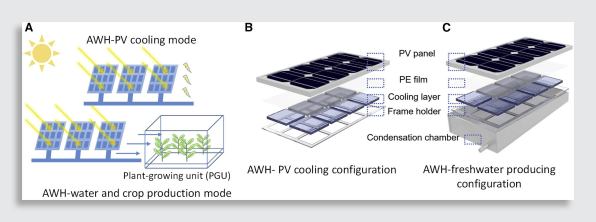- | 9:14 am
How scientists grew spinach in the desert by harvesting water out of thin air

Saudi Arabian summers may be dry and scorching hot, but in June last year, some 50 miles north of Jeddah, 57 seeds sprouted into healthy, seven-inch-tall water spinach leaves by harvesting water out of thin air.
Like all conventional crops, spinach needs water to grow. But, in this case, the spinach sprouted thanks to a solar-powered system that pulled vapor from the air and condensed it into two liters of water. Now published in the journal Cell Reports Physical Science, the results of the experiment suggest that small farms in remote, arid regions can grow their own crops without a water supply.

[Image: courtesy KAUST]
“If you have river water or lake water, you probably don’t need the system, but in places where you don’t have a conventional water system, it’s important,” says Peng Wang, a professor of environmental science and engineering at the King Abdullah University of Science and Technology (KAUST) and a senior author of the study.The prototype used during the experiment consists of three main components: a small-scale photovoltaic panel, a composite material made of hydrogel (a high-tech version of the hydrogel used in bandages to re-hydrate wounds), calcium chloride (the kind of salt we use to de-ice roads), plus a metal container that acts as a condensation chamber.
Like most conventional solar panels, 10-20% of the solar energy they absorb is converted to electricity. The remaining 80-90% is converted to heat. The hydrogel material—think of it as a layer of jelly attached to the backside of the solar panel—plays a dual role. First, it can cool the solar panel so it doesn’t overheat. Second, it can absorb water vapor from the air because of the calcium chloride, which can absorb more than its weight in moisture. The hydrogel itself swells and locks that moisture into the material so it doesn’t spill.
But wait: We’re in the Saudi Arabian desert. Where is all that moisture coming from? Deserts may be dry, but that’s not say there are no moisture particles in the air. The relative humidity in the region revolves around 40%, but Wang says it’s closer to 80% at night. As a result, the hydrogel material typically absorbs water vapor during the evening and at night. “We designed the system this way; nature asked us to,” says Wang.

[Image: courtesy KAUST]
By the morning, the material is saturated with moisture, so when the sun hits the solar panels, and the heat from the solar panels comes into contact with the material, it turns the moisture into vapor and drives it out of the hydrogel layer. The metal box below then collects the vapor and condenses it into water. The best part? None of these steps consume the electricity generated by the solar panel, meaning that if the system gets scaled up, the electricity produced by the panels could be fed directly into the grid, and the heat produced by the panels could be used to grow crops.
In this case, the scientists chose to grow water spinach, in part because the vegetable doesn’t require much water to grow, but also because of its relatively short growing period. The experiment only lasted two weeks, but the spinach grew seven inches tall. Wang says other crops could be grown in a similar way, but given the infrastructure required, it wouldn’t be suitable for water-intensive crops like rice or sugarcane. In theory, the water is potable, but for it to be consumed on a regular basis, minerals would need to be added because it is produced by water evaporation, not sourced from underground reservoirs and mineral springs.
To grow more water-intensive crops, the system could be scaled up with more solar panels, but as Wang says: “The water is very special, it’s from thin air,” so it would only make sense to use it sparingly. Wang says it could be used in more tempered climates with higher levels of humidity as well. In any case, trying it with a full-sized solar panel would need to come first.
There are many steps before the system can be commercialized—for one, the scientists need to find industrial collaborators who can manufacture the system cost-effectively—but if it ever does, Wang says it could be used in off-grid communities around the world. Last year, Wang and other scientists at KAUST developed a prototype for a cooling system that runs solely on sunlight and saltwater. Now, this new prototype brings electricity, water, and agriculture into the equation. “For a single household living in the mountain, or a very small community living in the middle of nowhere, this system can really help get those very basic human needs,” he says.








































